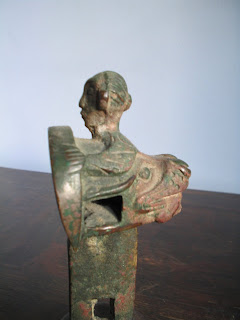The axle pin (fig 1 and 3) comes from a Western Zhou chariot dated probably about 900-800 BC and from Shandong Province, depicting this dual image of tiger and man, probably from the chariot of a local ruler. Looking carefully at the image we can see that the man’s buttocks are also the tiger’s nose, that the man’s back is the tiger’s forehead, and one of the man’s feet is the tiger’s tongue. It is difficult to discern where the man ends and the tiger begins. I haven’t been able to trace a comparable image in the literature but my hunch, and that of two academics I have spoken to, is that this depicts a trance state that the shaman enters into with the animal, facilitating the crossing to the other world. Maybe this represents the moment beyond the meeting of the shaman at the mouth of the tiger as the world of the ancestors is approached.
A Clearer Picture of a Later Shamanic Ritual
In 1955 Arthur Waley published a translation of nine particularly beautiful love poems called The Nine Songs which come from a larger collection written in the middle of the fourth century BC, and they describe shamanistic rituals, enactments of brief sexual encounters with specific gods – passionate trysts where the god is lured into a liaison often by a shamaness who is rapidly left abandoned. The shamaness can never possess the god and all too soon the tryst is over, with the fickle god moving on, always a cause of great sadness in the poems. The Songs would have been part of a formal ritual and there are references in them to the ritual taking place in a formal hall, probably built for the purpose. The shamaness’s objective would be pleading with the god on behalf of the people to secure promises of good harvests, immunity from floods and diseases etc. This is a quote from one of the songs where it is the shamaness speaking:
“The night grows pale; now it is broad daylight.
He harnesses his dragon-shaft, rides on his thunder-wheels,
He carries banners of clouds that twist and trail.
But he heaves a great sigh and when he is about to rise
He cannot make up his mind; he looks back full of yearning.
Beauty and music are things to delight in!
He that looks lingers, and forgets to go on his way.
The zithern strings are tightened; drum answers drum.
The bells are beaten till the bell-stand rocks.
Sound of flute, blowing of the reed organ;
A clever and beautiful spirit-guardian
Lightly fluttering on halcyon wings.
Verses chanted to fit the dance,
Singers who keep their pitch, instruments in strict measure;
The coming of many spirits cover the Sun
Coat of blue cloud, skirt of white rainbow.”
A Clearer Picture of a Later Shamanic Ritual
In 1955 Arthur Waley published a translation of nine particularly beautiful love poems called The Nine Songs which come from a larger collection written in the middle of the fourth century BC, and they describe shamanistic rituals, enactments of brief sexual encounters with specific gods – passionate trysts where the god is lured into a liaison often by a shamaness who is rapidly left abandoned. The shamaness can never possess the god and all too soon the tryst is over, with the fickle god moving on, always a cause of great sadness in the poems. The Songs would have been part of a formal ritual and there are references in them to the ritual taking place in a formal hall, probably built for the purpose. The shamaness’s objective would be pleading with the god on behalf of the people to secure promises of good harvests, immunity from floods and diseases etc. This is a quote from one of the songs where it is the shamaness speaking:
“The night grows pale; now it is broad daylight.
He harnesses his dragon-shaft, rides on his thunder-wheels,
He carries banners of clouds that twist and trail.
But he heaves a great sigh and when he is about to rise
He cannot make up his mind; he looks back full of yearning.
Beauty and music are things to delight in!
He that looks lingers, and forgets to go on his way.
The zithern strings are tightened; drum answers drum.
The bells are beaten till the bell-stand rocks.
Sound of flute, blowing of the reed organ;
A clever and beautiful spirit-guardian
Lightly fluttering on halcyon wings.
Verses chanted to fit the dance,
Singers who keep their pitch, instruments in strict measure;
The coming of many spirits cover the Sun
Coat of blue cloud, skirt of white rainbow.”

No comments:
Post a Comment